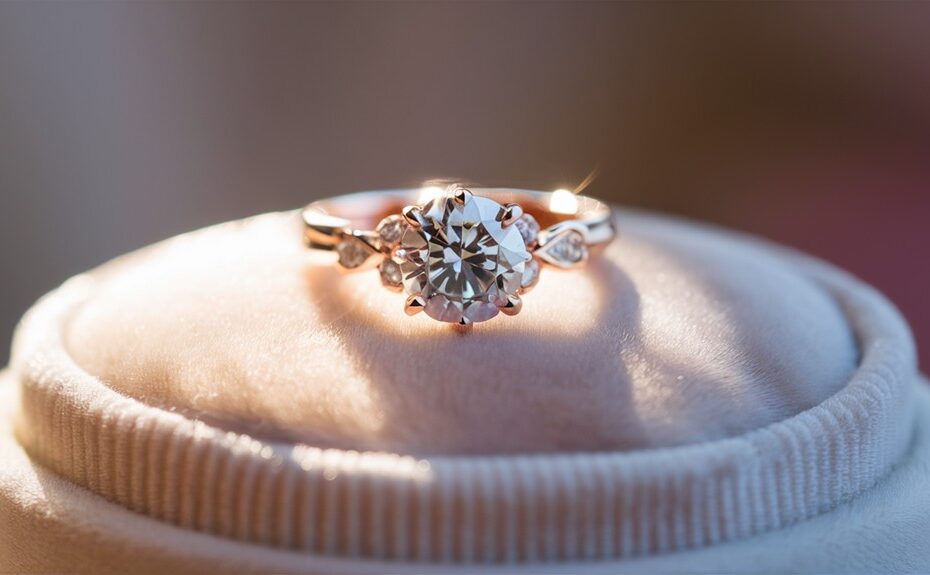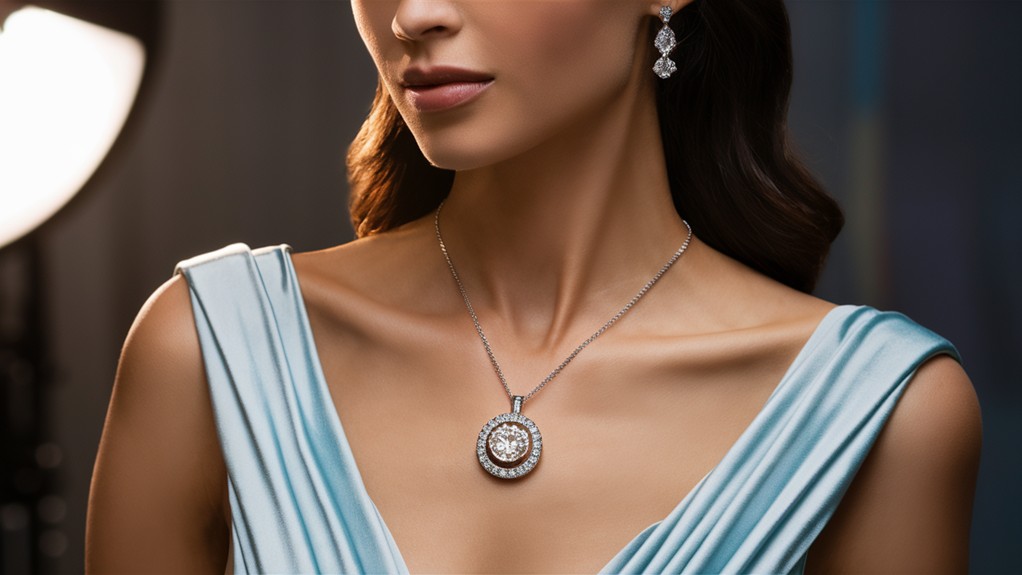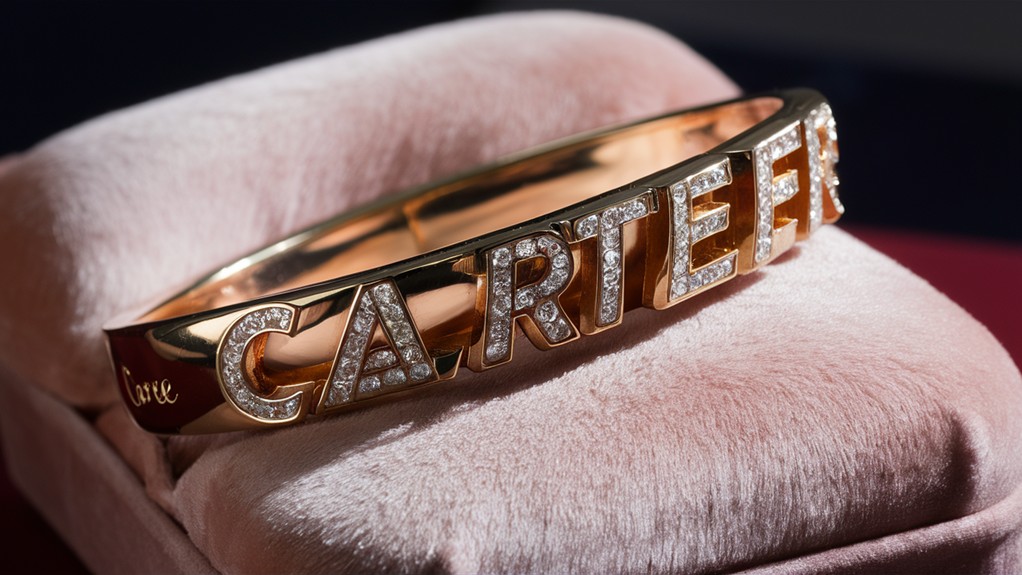When you're searching for the perfect engagement ring, you might find yourself drawn to the warm, rosy hue of rose gold. This trendy metal has won the hearts of many couples with its romantic appeal and vintage charm. But before you commit to a rose gold setting, it's crucial to understand both its allure and potential drawbacks. From its unique composition to its durability and aesthetic considerations, rose gold offers a distinct set of pros and cons that could influence your decision. As you investigate this enchanting option, you'll uncover why it's more than just a pretty face in the world of precious metals.
Our Highlighted Points
- Rose gold rings offer superior strength and scratch resistance due to their copper content.
- The distinctive pink hue flatters multiple skin tones and provides a romantic, vintage-inspired look.
- Rose gold requires less maintenance than white gold as it doesn't need rhodium plating.
- Copper content may cause allergic reactions in sensitive individuals.
- Rose gold rings may be less widely available and potentially subject to color changes over time.
What Is Rose Gold?

Uncover the allure of rose gold, a fascinating alloy that's making waves in the world of engagement rings. This unique metal is composed primarily of gold and copper, with the precise proportions determining its distinctive pink hue and durability.
In 14k rose gold, you'll find approximately 58.5% gold and 41.5% copper, resulting in a deeper, richer color. For a lighter shade, 18k rose gold contains about 75% pure gold.
Unlike pure 24k gold, which is too soft for everyday wear, rose gold's alloy composition improves its durability, making it an excellent choice for engagement rings. This metal's unique color has gained popularity because of its vintage appeal and ability to complement a wide range of skin tones.
When considering rose gold for your engagement ring, keep in mind:
- Composition: The alloy's gold-to-copper ratio affects color and durability.
- Karat options: Higher karats (18k) offer lighter shades, while lower karats (14k) provide deeper tones.
- Durability: Rose gold's alloy nature makes it more suitable for daily wear than pure gold.
- Versatility: Its warm hue complements multiple skin tones and gemstone choices.
History of Rose Gold
Rose gold's rich history dates back to the early 19th century, originating in Russia where it was initially dubbed "Russian gold." This enchanting metal's passage through time has seen it rise to prominence, fall from favor, and experience a remarkable resurgence.
The unique pink hue of rose gold, achieved through the alloying of gold with copper, has enthralled jewelry enthusiasts for generations.
In the 1920s, rose gold gained widespread recognition, particularly in Art Deco jewelry. Its association with elegance and luxury made it a popular choice for royal and aristocratic jewelry pieces.
The metal's vintage appeal has contributed to its resurgence in popularity since the early 2000s, often symbolizing romantic and sentimental values.
The history of rose gold is characterized by:
- Its Russian origins and initial popularity
- Prominence in Art Deco designs of the 1920s
- Use in royal and aristocratic jewelry
- A period of decline in popularity
- Resurgence in the early 2000s
Today, rose gold continues to be a favored choice for engagement rings, offering a unique blend of durability and aesthetic appeal.
Composition and Properties

The allure of rose gold lies in its unique composition and enchanting properties. When considering rose gold engagement rings, it's crucial to understand the alloy used and its characteristics:
Composition:
- Mainly gold (typically 58.5% in 14k)
- Copper content for distinctive pink hue
- Higher copper percentage results in deeper red tones
Properties:
- Durability: Rose gold is more durable than yellow gold because of its alloy composition, making it suitable for everyday wear.
- Versatility: The unique color complements different skin tones and gemstones.
- Vintage appeal: Its warm hue evokes a romantic, vintage aesthetic.
Metal choice considerations:
- Strength: Rose gold's copper content improves its resistance to scratches and dents.
- Allergenic potential: If you're allergic to copper, rose gold may not be suitable.
- Color variations: 14k rose gold appears more pink than 18k because of higher copper content.
When selecting a rose gold engagement ring, weigh these factors against your personal preferences and lifestyle.
The metal's durability and unique appearance make it an attractive option for those seeking a distinctive, long-lasting symbol of commitment.
Advantages of Rose Gold Rings
Embracing rose gold for your engagement ring offers a multitude of advantages. This unique metal composition provides a blend of durability, affordability, and aesthetic appeal that sets it apart from traditional options.
Durability:
- Rose gold engagement rings boast superior strength owing to their higher copper content.
- Improved resistance to scratches guarantees your ring maintains its beauty over time.
Affordability:
- Typically 40-50% less expensive than platinum, making it an attractive choice for budget-conscious couples.
- Offers a high-end look without the premium price tag.
Aesthetic Appeal:
- The distinctive pink hue complements a wide range of skin tones, flattering both warm and cool complexions.
- Romantic and vintage-inspired appearance adds a touch of uniqueness to both contemporary and classic designs.
Maintenance:
- Unlike white gold, rose gold doesn't require rhodium plating.
- Diminished need for professional upkeep simplifies long-term care and maintenance.
Drawbacks of Rose Gold Rings
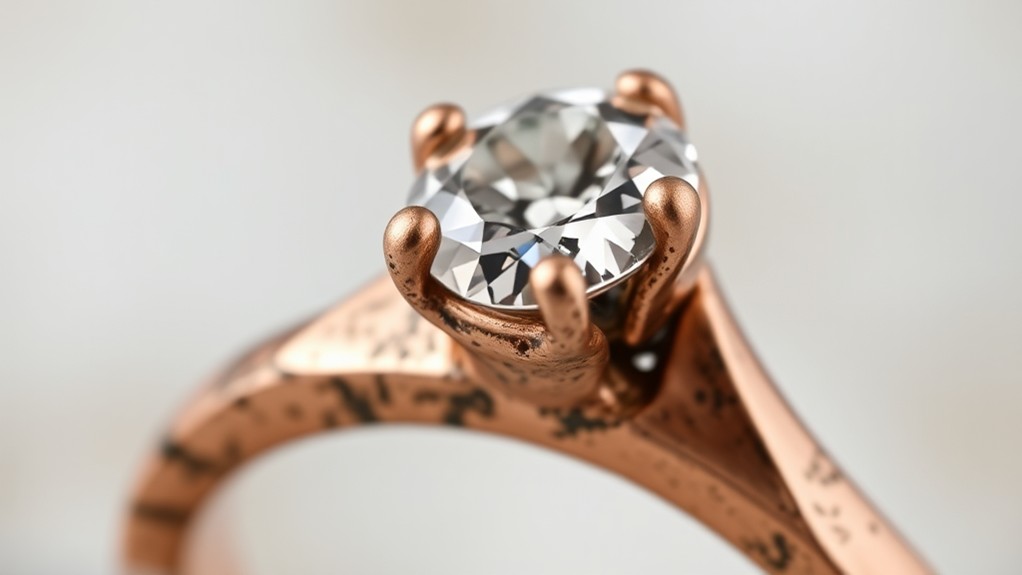
In spite of its allure, rose gold engagement rings come with their own set of drawbacks that you should consider before making your purchase. Here are the key issues to keep in mind: One of the main drawbacks of rose gold engagement rings is that the color may fade over time and require re-plating. Additionally, some individuals may be allergic to the alloys used in rose gold, which can cause skin irritation. Another important consideration is that rose gold may not be as durable as other metals, making it more prone to scratching and damage, especially in thin wedding bands. It’s important to weigh these factors against the beauty and appeal of rose gold before making your decision.
- Allergic reactions: Rose gold rings aren't hypoallergenic because of their copper content, which may cause skin irritation in sensitive individuals.
- Limited availability: Finding your desired style might be challenging, as rose gold options are less abundant compared to yellow and white gold.
- Color changes: Over time, the pink hue may darken and redden as a result of oxidation, potentially altering the ring's appearance.
- Trendiness concerns: Rose gold's popularity fluctuates, making it a potentially trendy choice that risks becoming outdated for those seeking timeless elegance.
- Fading and maintenance: The color of rose gold may fade with regular wear, requiring consistent care to maintain its luster and appearance.
- Softness: Rose gold is relatively soft for jewelry, making it more susceptible to scratches and dents compared to other metals.
To lessen these drawbacks, you'll need to invest time and effort in proper maintenance, be prepared for potential allergic reactions, and consider the long-term appeal of rose gold in your jewelry collection.
Rose Gold vs. Other Metals
While evaluating the drawbacks of rose gold rings is significant, comparing them to other metals can help you make an informed decision.
Rose gold jewelry offers unique advantages over traditional yellow or white gold engagement ring settings:
- Durability: Rose gold's higher copper content makes it more durable than 18k yellow and white gold options.
- Maintenance: Unlike white gold, rose gold doesn't require rhodium plating, simplifying upkeep.
- Vintage appeal: Rose gold has surged in popularity since the 2000s, offering a trendy alternative to classic yellow gold.
- Allergies: For those with nickel sensitivities, rose gold is often a better choice than white gold, which frequently contains nickel.
- Cost: Rose gold is generally more affordable than platinum and comparable to or less expensive than yellow gold.
However, there are pros and cons to assess:
- The copper content in rose gold may cause allergic reactions in some individuals.
- While rose gold's unique pink hue is attractive, it may not suit all skin tones or personal preferences.
- The vintage appeal of rose gold mightn't align with those seeking a more traditional look.
When choosing between rose gold and other metals, evaluate your budget, style preferences, and any potential allergies to make the best decision for your engagement ring.
Caring for Rose Gold Jewelry
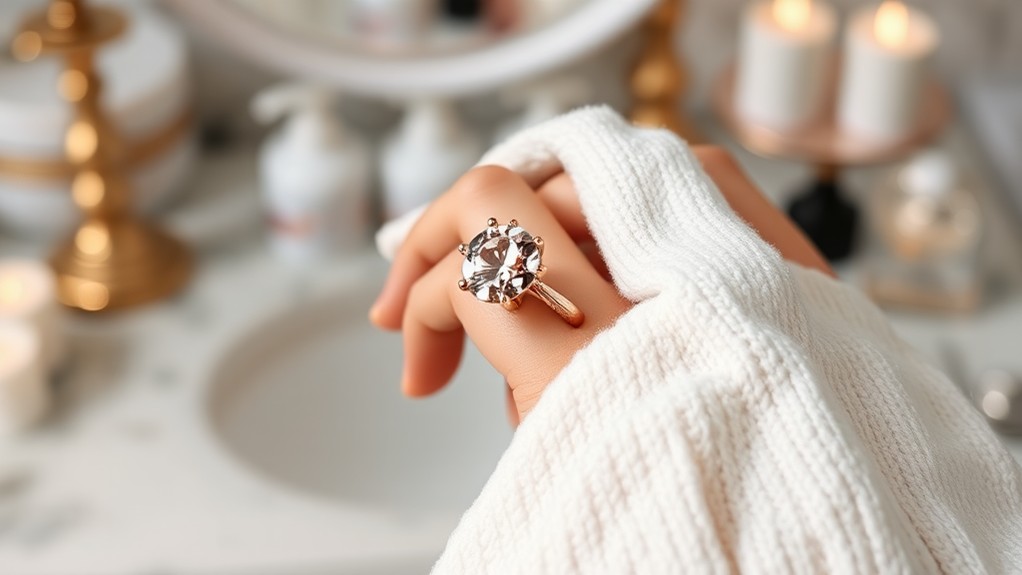
The allure of rose gold jewelry extends beyond its beauty; proper care guarantees its longevity. To maintain the lustrous shine of your rose gold pieces, regular cleaning is vital.
Create a gentle cleaning solution by mixing 1 teaspoon of dish soap with 1 cup of warm water. Using a soft-bristled toothbrush, carefully scrub the jewelry to remove dirt and grime. Rinse thoroughly with clean water to eliminate any soap residue.
To avoid tarnishing, store your rose gold jewelry in a dry place, away from moisture and harsh chemicals. Keep each piece in a separate cloth or pouch to prevent scratches.
It's fundamental to protect your jewelry from abrasive materials and chemicals that can damage the surface over time.
While at-home care is significant, professional cleaning and inspection should be done at least once a year. This guarantees that any wear is identified early and that stones remain securely set in their prongs.
Choosing Your Rose Gold Ring
Selecting the perfect rose gold engagement ring involves several key considerations. Initially, determine the karat weight that suits your preferences: 14k rose gold offers a deeper red hue and increased durability, while 18k provides a lighter shade with higher gold content.
Consider how the unique pink tone complements your skin tone and personal style.
When choosing your rose gold ring, be mindful of potential allergies. If you have sensitive skin or known metal sensitivities, consult with a jeweler about the alloy composition, as 14k rose gold may contain silver or zinc.
Gemstone pairing is essential for your engagement ring's overall aesthetic. Diamonds typically complement rose gold well, but carefully evaluate colored stones for compatibility with the metal's pink tones.
Assess the ring's durability based on your lifestyle. 14k rose gold offers greater resistance to scratches and wear, making it suitable for everyday use.
To make an informed decision:
- Compare 14k and 18k options side by side
- Try on different styles to gauge how they suit your hand
- Examine multiple gemstone pairings with rose gold settings
- Discuss maintenance requirements with your jeweler
Frequently Asked Questions
What Metal Looks Best With Rose Gold?
You'll find that white gold creates a stunning contrast with rose gold, enhancing its warm tones. However, yellow gold offers a classic pairing, while platinum provides durability. Silver's lighter hue can additionally complement rose gold beautifully.
Is Rose Gold a Good Choice for an Engagement Ring?
Yes, rose gold can be an excellent choice for your engagement ring. It's durable, unique, and low-maintenance. You'll love its romantic hue and vintage appeal. It's trendy yet timeless, making it a stylish option for daily wear.
Do Rose Gold Engagement Rings Tarnish?
Yes, rose gold engagement rings can tarnish over time. You'll notice the copper content may oxidize, causing a darker hue. However, you can prevent tarnishing with regular cleaning and maintenance. Don't worry, it's manageable with proper care.
Does Rose Gold Scratch Easily?
No, rose gold doesn't scratch easily. You'll find it's more durable than yellow or white gold because of its higher copper content. While it can get minor scratches over time, it's generally resistant to everyday wear and tear.
